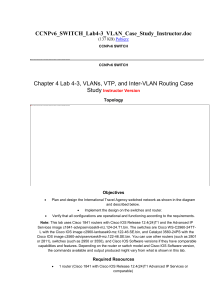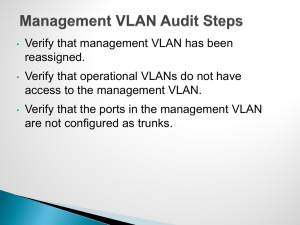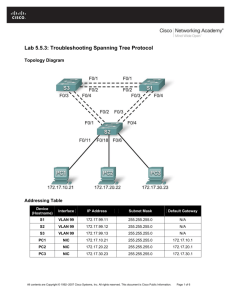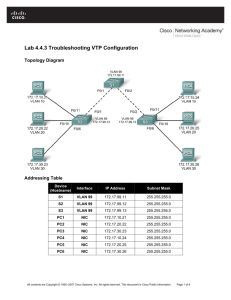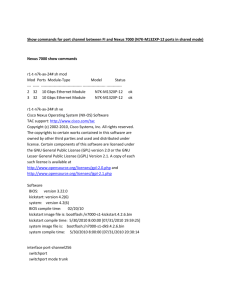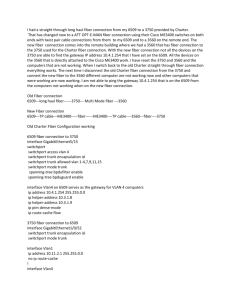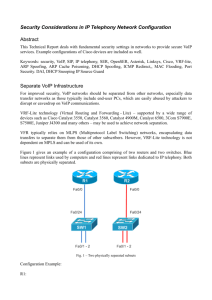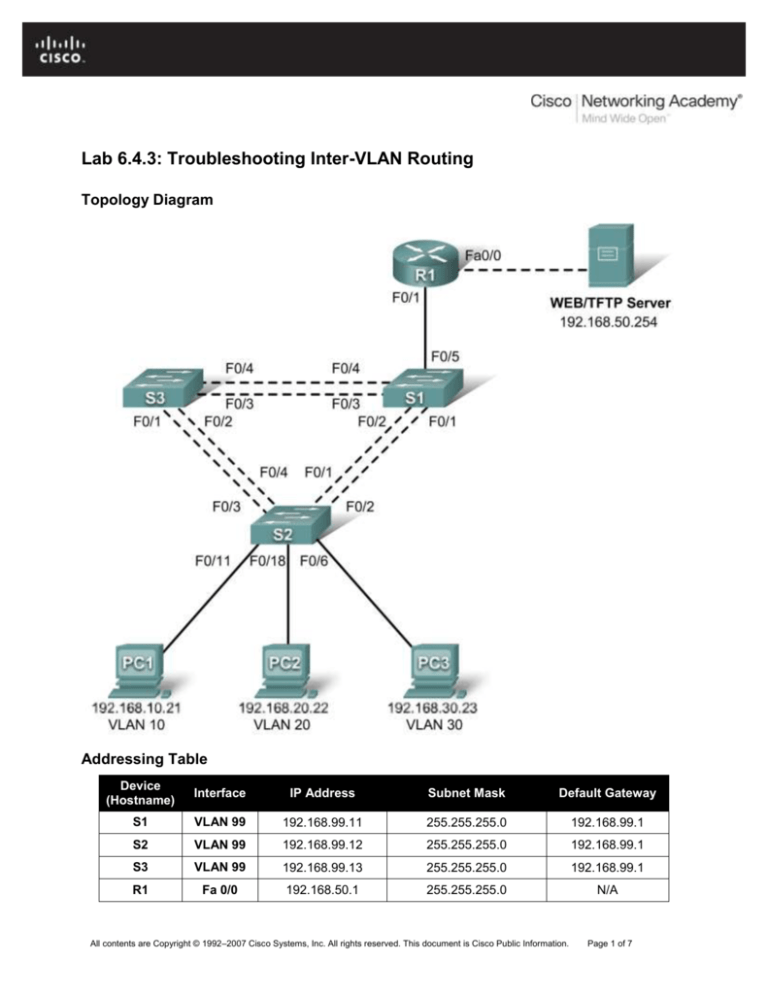
Lab 6.4.3: Troubleshooting Inter-VLAN Routing
Topology Diagram
Addressing Table
Device
(Hostname)
Interface
IP Address
Subnet Mask
Default Gateway
S1
VLAN 99
192.168.99.11
255.255.255.0
192.168.99.1
S2
VLAN 99
192.168.99.12
255.255.255.0
192.168.99.1
S3
VLAN 99
192.168.99.13
255.255.255.0
192.168.99.1
R1
Fa 0/0
192.168.50.1
255.255.255.0
N/A
All contents are Copyright © 1992–2007 Cisco Systems, Inc. All rights reserved. This document is Cisco Public Information.
Page 1 of 7
CCNA Exploration
LAN Switching and Wireless: Inter-VLAN Routing
Lab 6.4.3: Troubleshooting Inter-VLAN Routing
R1
Fa 0/1
PC1
NIC
192.168.10.21
255.255.255.0
192.168.10.1
PC2
NIC
192.168.20.22
255.255.255.0
192.168.20.1
PC3
NIC
192.168.30.23
255.255.255.0
192.168.30.1
Server
NIC
192.168.50.254
255.255.255.0
192.168.50.1
See Subinterface Configuration Table
N/A
Port Assignments – Switch 2
Ports
Fa0/1 – 0/5
Fa0/6 – 0/10
Fa0/11 – 0/17
Fa0/18 – 0/24
Assignment
802.1q Trunks (Native VLAN 99)
VLAN 30 – Sales
VLAN 10 – R&D
VLAN 20 – Engineering
Network
192.168.99.0 /24
192.168.30.0 /24
192.168.10.0 /24
192.168.20.0 /24
Subinterface Configuration Table – Router 1
Router Interface
Fa0/1.1
Fa0/1.10
Fa0/1.20
Fa0/1.30
Fa0/1.99
Assignment
VLAN1
VLAN 10
VLAN 20
VLAN 30
VLAN 99
IP Address
192.168.1.1
192.168.10.1
192.168.20.1
192.168.30.1
192.168.99.1
Learning Objectives
To complete this lab:
Cable a network according to the topology diagram
Erase any existing configurations and reload switches and the router to the default state
Load the switches and the router with supplied scripts
Find and correct all configuration errors
Document the corrected network
Scenario
The network has been designed and configured to support five VLANs and a separate server network.
Inter-VLAN routing is being provided by an external router in a router-on-a-stick configuration, and the
server network is routed across a separate Fast Ethernet interface. However, it is not working as
designed, and complaints from your users have not given much insight into the source of the problems.
You must first define what is not working as expected, and then analyze the existing configurations to
determine and correct the source of the problems.
This lab is complete when you can demonstrate IP connectivity between each of the user VLANs and the
external server network, and between the switch management VLAN and the server network.
Task 1: Prepare the Network
Step 1: Cable a network that is similar to the one in the topology diagram.
The output shown in this lab is based on 2960 switches and an 1841 router. You can use any current
switches or routers in your lab as long as they have the required interfaces shown in the topology
All contents are Copyright © 1992–2007 Cisco Systems, Inc. All rights reserved. This document is Cisco Public Information.
Page 2 of 7
CCNA Exploration
LAN Switching and Wireless: Inter-VLAN Routing
Lab 6.4.3: Troubleshooting Inter-VLAN Routing
diagram. Other device types may produce different output. Note that Ethernet (10Mb) LAN interfaces on
routers do not support trunking, and Cisco IOS software earlier than version 12.3 may not support
trunking on Fast Ethernet router interfaces.
Set up console connections to all three switches and to the router.
Step 2: Clear any existing configurations on the switches.
Clear switch configurations on all three switches, and reload to restore the default state. Use the show
vlan command to confirm that only default VLANs exist and that all ports are assigned to VLAN 1.
Step 3: Configure the Ethernet interfaces on the host PCs and the server.
Configure the Ethernet interfaces of PC1, PC2, PC3 and the server with the IP addresses and default
gateways listed in the addressing table.
Task 2: Load the Router and Switches with Supplied Scripts
Router 1 Configuration
hostname R1
!
no ip domain lookup
!
interface FastEthernet0/0
ip address 192.168.50.1 255.255.255.192
!
interface FastEthernet0/1
no ip address
!
interface FastEthernet0/1.1
encapsulation dot1Q 1
ip address 192.168.1.1 255.255.255.0
!
interface FastEthernet0/1.10
encapsulation dot1Q 11
ip address 192.168.10.1 255.255.255.0
!
interface FastEthernet0/1.20
encapsulation dot1Q 20
ip address 192.168.20.1 255.255.255.0
!
interface FastEthernet0/1.30
ip address 192.168.30.1 255.255.255.0
!
interface FastEthernet0/1.99
encapsulation dot1Q 99 native
ip address 192.168.99.1 255.255.255.0
!
line con 0
logging synchronous
password cisco
login
!
line vty 0 4
password cisco
login
!
All contents are Copyright © 1992–2007 Cisco Systems, Inc. All rights reserved. This document is Cisco Public Information.
Page 3 of 7
CCNA Exploration
LAN Switching and Wireless: Inter-VLAN Routing
Lab 6.4.3: Troubleshooting Inter-VLAN Routing
end
Switch 1 Configuration
hostname S1
!
vtp mode server
vtp domain lab6_3
vtp password cisco
!
vlan 99
name Management
exit
!
vlan 10
name R&D
exit
!
vlan 30
name Sales
exit
!
interface FastEthernet0/1
switchport trunk native vlan
switchport mode trunk
no shutdown
!
interface FastEthernet0/2
switchport trunk native vlan
switchport mode trunk
no shutdown
!
interface FastEthernet0/3
switchport trunk native vlan
switchport mode trunk
no shutdown
!
interface FastEthernet0/4
switchport trunk native vlan
switchport mode trunk
shutdown
!
interface FastEthernet0/5
switchport trunk native vlan
switchport mode trunk
99
99
99
99
99
!
interface range FastEthernet0/6 - 24
shutdown
!
interface Vlan99
ip address 192.168.99.11 255.255.255.0
no shutdown
!
exit
!
ip default-gateway 192.168.99.1
All contents are Copyright © 1992–2007 Cisco Systems, Inc. All rights reserved. This document is Cisco Public Information.
Page 4 of 7
CCNA Exploration
LAN Switching and Wireless: Inter-VLAN Routing
Lab 6.4.3: Troubleshooting Inter-VLAN Routing
!
line con 0
logging synchronous
password cisco
login
!
line vty 0 4
password cisco
login
!
line vty 5 15
password cisco
login
!
end
Switch 2 Configuration
!
hostname S2
no ip domain-lookup
enable secret class
!
vtp mode client
vtp domain lab6_3
vtp password cisco
!
interface FastEthernet0/1
switchport trunk native vlan 99
switchport mode trunk
!
interface FastEthernet0/2
switchport trunk native vlan 99
switchport mode trunk
!
interface FastEthernet0/3
switchport trunk native vlan 99
switchport mode trunk
!
interface FastEthernet0/4
switchport trunk native vlan 99
switchport mode trunk
!
interface FastEthernet0/5
switchport trunk native vlan 99
switchport mode trunk
!
interface range FastEthernet0/6 - 11
switchport access vlan 30
switchport mode access
!
interface range FastEthernet0/12 - 17
switchport access vlan 10
!
interface range FastEthernet0/18 -24
switchport mode access
switchport access vlan 20
All contents are Copyright © 1992–2007 Cisco Systems, Inc. All rights reserved. This document is Cisco Public Information.
Page 5 of 7
CCNA Exploration
LAN Switching and Wireless: Inter-VLAN Routing
Lab 6.4.3: Troubleshooting Inter-VLAN Routing
!
interface Vlan99
ip address 192.168.99.12 255.255.255.0
no shutdown
exit
!
ip default-gateway 192.168.99.1
ip http server
!
line con 0
password cisco
logging synchronous
login
line vty 0 4
password cisco
login
line vty 5 15
password cisco
login
!
end
Switch 3 Configuration
!
hostname S3
!
enable secret class
!
vtp mode client
vtp domain lab6_3
vtp password cisco
!
interface FastEthernet0/1
switchport trunk native vlan
switchport mode trunk
no shutdown
!
interface FastEthernet0/2
switchport trunk native vlan
switchport mode trunk
no shutdown
!
interface FastEthernet0/3
switchport trunk native vlan
switchport mode trunk
no shutdown
!
interface FastEthernet0/4
switchport trunk native vlan
switchport mode trunk
no shutdown
!
interface FastEthernet0/5
switchport trunk native vlan
switchport mode trunk
99
99
99
99
99
All contents are Copyright © 1992–2007 Cisco Systems, Inc. All rights reserved. This document is Cisco Public Information.
Page 6 of 7
CCNA Exploration
LAN Switching and Wireless: Inter-VLAN Routing
Lab 6.4.3: Troubleshooting Inter-VLAN Routing
!
interface range FastEthernet0/6 - 24
shutdown
exit
!
ip default-gateway 192.168.99.1
!
line con 0
logging synchronous
password cisco
login
!
line vty 0 4
password cisco
login
!
line vty 5 15
password cisco
login
!
end
Task 3: Troubleshoot and Correct the Inter-VLAN Issues and Configuration Errors
Begin by identifying what is working and what is not. What is the state of the interfaces? What hosts can
ping other hosts? Which hosts can ping the server? What routes should be in the R1 routing table? What
could prevent a configured network from being installed in the routing table?
When all errors are corrected, you should be able to ping the remote server from any PC or any switch. In
addition, you should be able to ping between the three PCs and ping the management interfaces on
switches from any PC.
Task 4: Document the Network Configuration
When you have successfully completed your troubleshooting, capture the output of the router and all
three switches with the show run command and save it to a text file.
Task 5: Clean Up
Erase the configurations and reload the switches and router. Disconnect and store the cabling. For PC
hosts that are normally connected to other networks (such as the school LAN or to the Internet),
reconnect the appropriate cabling and restore the TCP/IP settings.
All contents are Copyright © 1992–2007 Cisco Systems, Inc. All rights reserved. This document is Cisco Public Information.
Page 7 of 7


